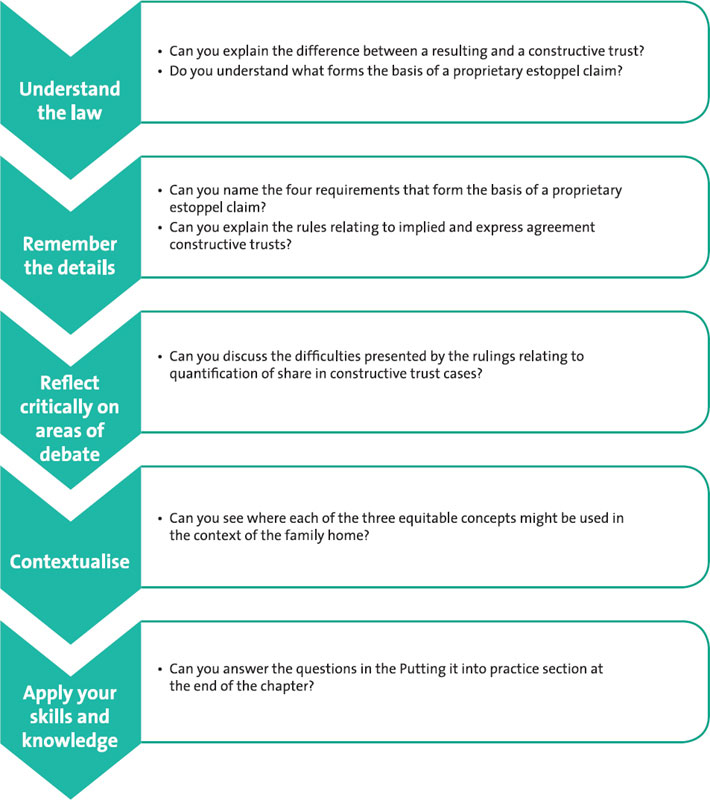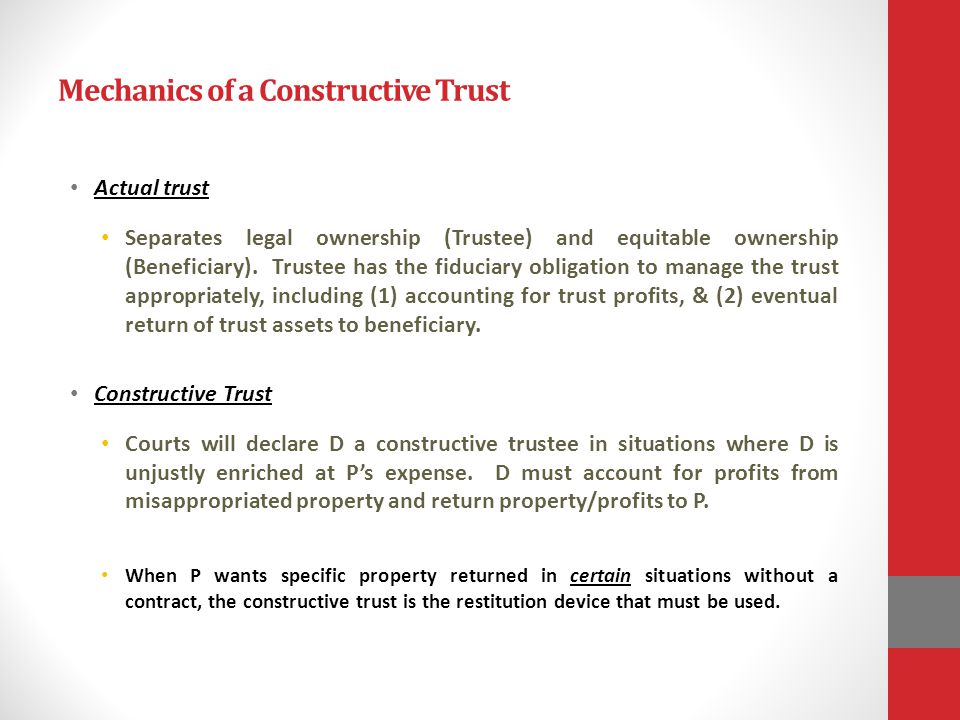Revealing the Benefits of a Positive Count On Dealing With Recipient Problems
The principle of a positive trust emerges as a critical tool in the elaborate realm of beneficiary conflicts, providing a nuanced service to conflicts that typically develop from wrongful property retention. By fostering a fiduciary relationship in between events, this fair solution not just assists in swift resolutions yet additionally offers to prevent prospective misbehavior. As we explore the multifaceted benefits of positive depends on, one may begin to question just how these devices can reshape the landscape of estate disputes and add to a more fair circulation of possessions among recipients.
Interpretation of Constructive Trust Fund
A useful count on is frequently developed by courts to attend to circumstances where one party has actually wrongfully gotten or maintained home that rightfully comes from one more (What Is A Constructive Trust). This legal concept is not a typical depend on, as it does not need the formalities typically associated with trust fund development, such as a composed agreement or the objective of the events included. Rather, a useful trust develops by operation of regulation, working as a fair remedy to protect against unfair enrichment
The courts enforce a useful trust when it is established that a person event holds home under circumstances that, in equity and great principles, ought to not allow them to retain it. Typical scenarios include illegal actions, violations of fiduciary obligation, or situations where an event has obtained property with inappropriate means. The useful trust fund thus works to shield the rights of the rightful owner by making certain that the residential or commercial property is held for their advantage.
As soon as established, the useful trust fund calls for the party in belongings of the building to convey it to the rightful owner, thus fixing the wrongful situation. This mechanism highlights the legal system's dedication to justness and justice in property disputes, highlighting the value of moral conduct in possession and transfer of properties.
Advantages of Positive Counts On
Constructive counts on provide a number of considerable benefits in legal disputes involving home legal rights. Mostly, they work as an equitable treatment, allowing courts to address situations where a party has actually wrongfully gotten or maintained residential property that truly belongs to another. This develops a structure for fairness, making sure that the rightful owner is compensated and the unjustified enrichment of the crook is stopped.
Moreover, positive depends on can speed up resolution in conflicts over estate properties, consequently decreasing the typically contentious and extensive litigation procedures linked with standard home disputes. Their adaptability enables courts to tailor treatments to fit the specific conditions of each situation, which can lead to even more adequate outcomes for all celebrations involved.
In addition, constructive trust funds promote openness and responsibility amongst beneficiaries and fiduciaries, as they require the last to act in the finest passions of the former. This enhances the integrity of fiduciary connections, fostering depend on and cooperation. By preventing transgression related to home possession, positive trusts contribute to the overall stability of monetary and lawful systems, making certain that property rights are respected and supported within society.
Exactly How Useful Depends On Job

In technique, when a positive trust is imposed, the court identifies the home in inquiry and develops a fiduciary partnership in between the events entailed. The event that holds the property becomes a trustee, obligated to manage it for the benefit of the rightful owner, understood as the beneficiary. This connection is not based upon a formal agreement but rather on the concept of equity, intending to remedy circumstances where one celebration's gain directly correlates with another's loss.

Situation Research Studies and Examples
When checking out the functional application of useful counts on, various instance research studies illustrate just how courts browse complicated situations including unjust enrichment. One notable instance is * Pettkus v. Becker *, where the Supreme Court of copyright developed a useful trust to fix the unfair enrichment of one party over an additional in a long-lasting relationship. The court established that the contributions of one companion to the purchase of property warranted the imposition of a positive count on, making certain equitable circulation.
One more substantial example is * Gisborne v. Gisborne *, where the court enforced a constructive depend on to address the cases of siblings over their departed bro's estate. The court recognized the payments made by the siblings in preserving the family residential property, resulting in a choice that required the estate to make up those contributions, thus protecting against unjust enrichment.
These situations exhibit how useful trust funds can efficiently solve disputes by concentrating on fairness and the prevention of unfair enrichment. By Click Here examining the particular contributions and scenarios of the events involved, courts can apply useful depend attain simply outcomes, ultimately strengthening the fair concepts underpinning these lawful devices.

Steps to Develop a Constructive Depend On
To develop a useful trust fund, several essential actions must be followed to make sure that the case is validated and lawfully identified. First, the plaintiff has to demonstrate the existence of a fiduciary connection or a scenario that warrants the imposition of a useful depend on, such as fraudulence, unjust enrichment, or a breach of task.
2nd, it is necessary to gather and present compelling evidence that supports the claim. This includes documentation and testimonies that illustrate the circumstances resulting in the alleged wrongful retention of home or benefits by the trustee.
Third, the plaintiff ought to file a petition in the appropriate court, articulating the premises for asking for the charge of a useful depend on. This request should outline the specifics of the relationship and the unjust enrichment that demands the depend on.
Final Thought
In verdict, constructive depends on stand for an important fair remedy in the realm of recipient problems, effectively dealing with wrongful building retention and avoiding unfair enrichment. Inevitably, constructive counts on promote justness amongst recipients, ensuring that rightful ownership is preserved and secured.
A positive trust read the article is frequently established by courts to deal with circumstances where one event has actually wrongfully obtained or retained home that truly belongs to one more.The courts enforce a positive trust fund when it is determined that one party holds home under scenarios that, in equity and excellent principles, need to not allow them to preserve it. By inhibiting transgression relevant to property possession, positive trust funds add to the total security of legal and economic systems, making sure that residential property civil liberties are appreciated and supported within society.
In practice, when a constructive trust is enforced, the court recognizes the residential property in concern and establishes a fiduciary relationship between the events entailed. What Is A Constructive Trust. The court established that the payments of one partner to the acquisition of property justified the charge of a positive depend on, guaranteeing equitable circulation
Comments on “Real-Life Scenarios That Help Explain What Is A Constructive Trust in Court Decisions”